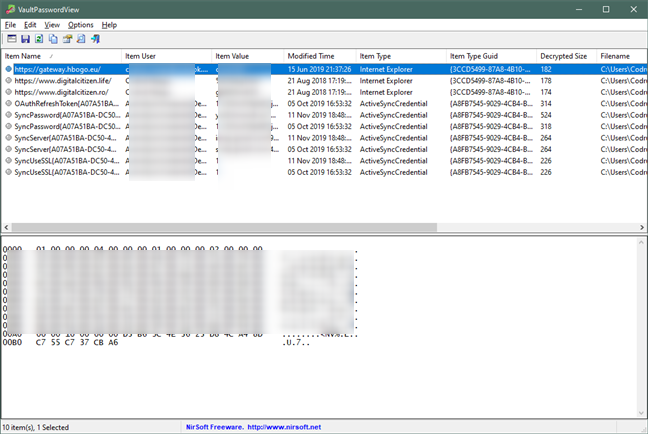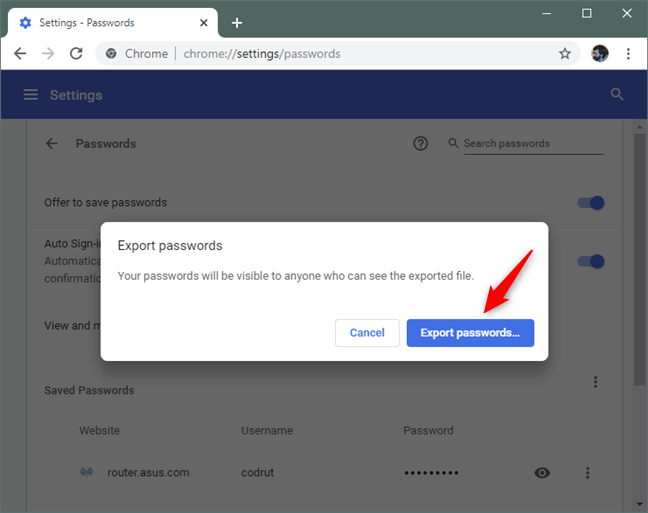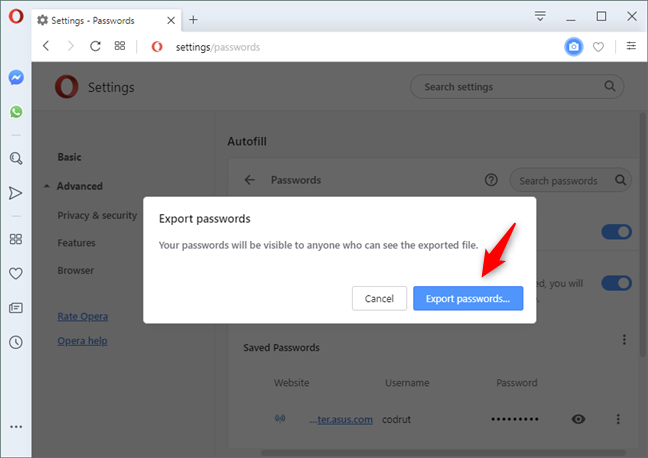
Web browsers, including popular ones such as Google Chrome, Mozilla Firefox, Opera, Microsoft Edge, and even Internet Explorer, can store your passwords. It is a useful feature to have in your web browser, as it makes it easier for you to sign in to your online accounts. However, if you are considering changing your primary web browser, or switching to a password manager, you might want to move all your passwords from the old web browser to the new one. A tedious way is to do it site by site, password by password. A much faster way is to export all your stored passwords at once from your browser and then import them where you need them. To help you start, we show you how to export all your passwords from Google Chrome, Mozilla Firefox, Opera, Microsoft Edge, and Internet Explorer.
NOTE: For creating this tutorial, we used the latest versions of the web browsers mentioned, available at the time of writing: Google Chrome 78, Mozilla Firefox 70, Opera 64, Microsoft Edge 44, and Internet Explorer 11.
How to export passwords from Mozilla Firefox
Mozilla Firefox does not offer a built-in option to export your passwords. The only way you can quickly do it is by using a third-party tool. There are not many to be found on the internet, but we looked, and the best option we discovered is called FF Password Exporter. It is an open-source tool and was developed by Kyle Spearrin. You can find the tool on GitHub, at this address: FF Password Exporter. At the bottom of the page, click or tap on the download link that matches your operating system, choosing between the portable or the installable version of the tool.
We chose to use the portable version. Once you download it, double-click or double-tap on the FF-Password-Exporter-Portable-1.1.1 executable file.
The FF Password Exporter application is all about a small window with a few options. It should automatically detect your user profile from Firefox's installation folder. If it does not, you can use the "choose a custom profile directory" option to get to it.
If you have set a master password in your Firefox, enter it in the Firefox Master Password. Otherwise, leave this field blank.
Click or tap on Export Passwords.
Select the location (1) where the file with your passwords is going to be created, and then choose the name (2) and the type (3) of the file in which you want your passwords to be saved. By default, it is set to CSV, but you can also choose to use JSON.
If you intend to import your passwords in another web browser, such as Google Chrome, you should use the CSV file type. Once you've made your choices, click or tap Save (4).
That is it! Now all your passwords are available to see and use in the file that you created.
How to export passwords from Microsoft Edge or Internet Explorer
Microsoft chooses to store all the passwords you saved using Microsoft Edge and Internet Explorer, in the Web Credentials section from Windows' Credential Manager. You can read more in Credential Manager is where Windows stores passwords and login details. You can also use Credential Manager to export your saved passwords from Microsoft Edge and Internet Explorer by following the steps shown in How to backup and restore Windows Vault passwords. However, if you prefer an easier way, read the next paragraphs from this guide.
We managed to find an easy-to-use third-party tool that can export your saved passwords from Microsoft Edge and Internet Explorer at the same time. It's called VaultPasswordView, and it's developed by NirSoft. You can download it from here: VaultPasswordView.
What you get is a small ZIP file that you have to unzip somewhere on your computer. Then, open the VaultPasswordView folder and run the VaultPasswordView.exe file inside it.
Then, you should see a new window called Vault Decryption Options. Inside it, first, select "Decrypt vault files of any system - Requires to type the login password" (1). Then, in the "Root Folder" field, select the drive on which Windows is installed: this is usually the C: drive (2). Click or tap on Automatic Fill and the next fields are automatically filled with information: leave them as they are. Finally, type your user account password in the Windows Login Password field (4), and click or tap on OK (5).
If everything worked correctly, you should now see all the passwords saved by Windows for both Microsoft Edge and Internet Explorer.
Access the View menu and click or tap on HTML Report - All Items.
VaultPasswordView now creates an HTML report with all your saved passwords from Edge and Internet Explorer. This report is automatically loaded in your default web browser, but also stored as an HTML file in the VaultPasswordView folder. However, take note that the HTML report file is automatically deleted as soon as you close the VaultPasswordView app. It's essential to keep the app open for now, so just minimize it if it gets in your way.
If you want to keep the HTML file with your passwords, copy it somewhere safe before closing VaultPasswordView.
If you want to transform it into a CSV file, open it with Microsoft Excel (or LibreOffice Calc) and save it as a CSV file. In Microsoft Excel, for example, after you open the HTML report in it, click or tap File on the top menu.
Select Save As (1) on the left, choose where to save the file (2), type a name for it (3), and choose the file type (4) as CSV UTF-8 (Comma delimited) (*.csv). Then, click or tap on Save (5).
That's it: now you can close VaultPasswordView and use the HTML or CSV file that stores the passwords from your Edge or Internet Explorer browser as you see fit.
How to export passwords from Google Chrome
Start by opening Google Chrome. Then, open its menu by clicking or tapping on the button that looks like three suspension dots, found at the top-right corner of the window.
In Chrome's menu, click or tap on Settings.
A new tab called Settings opens up. In it, scroll until you get to the Autofill section and click or tap on Passwords.
Chrome should now load the Passwords settings. On the right side, click or tap on the Saved Passwords menu button, which looks like three dots stacked vertically.
The menu has only one option called Export passwords. Click or tap on it.
Then, Google Chrome tells you that "Your passwords will be visible to anyone who can see the exported file." That happens because all the passwords stored in your browser are saved in a CSV file that is not encrypted, and anyone can read it using any simple text editor. Click or tap on Export passwords.
Now Google Chrome asks where you want to save your passwords. Choose the location (1) and the name (2) you prefer for the CSV file, and then click or tap Save (3).
That is it! Now all your passwords are available to see and use in the CSV file that you specified.
How to export passwords from Opera
Start by opening Opera. Then, click or tap on the "O" button from the top-left corner of the window to access the browser's main menu. In it, select Settings.
On Opera's Settings page, click or tap on Advanced on the left, and select Privacy & security.
On the right side of the window, scroll until you get to the section called Autofill, and click or tap on Passwords.
Opera should now load a settings section called Saved Passwords. On the right side, look for the three dots button and click or tap on it.
The only option you get is Export passwords. Click or tap on it.
You are told that "Your password will be visible to anyone who can see the exported file." To continue, press the "Export passwords" button.
Choose the location you prefer and click or tap Save.
That is it! Now all your passwords are available to see and use in the file that you specified.
Why did you want to export the passwords you saved in your web browser?
Everybody has his or her reason for doing it. However, we are curious to hear, which was yours? Did you want to export your saved passwords from your browser because you wanted to move them to a new computer and import them into a new web browser? Maybe you wanted to move your passwords to a password management service? Are there any other reasons? Share your thoughts, questions or advice in the comments section below.


 13.11.2019
13.11.2019 






























